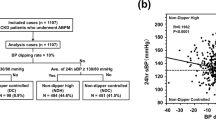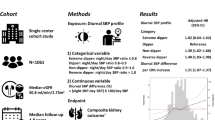Abstract
A non-dipping pattern in ambulatory blood pressure monitoring (ABPM) increases the risk of cardiovascular disease. The association between renal function and the dipping pattern has not been studied in a random middle-aged population. This is a cross-sectional population-based study of 226 males and 234 females aged 40 to 62 years. Renal function was assessed with estimated glomerular filtration rate (eGFR). Non-dipping status was defined as a reduction of <10% between the daytime and the nighttime systolic BP. Non-dippers represented 18.7% of the study population. Their mean eGFR was 79.1 (s.d. 15.7) ml min–1 per 1.73 m2 as compared with a mean eGFR of 84.1 (s.d. 16.2) ml min–1 per 1.73 m2 in dippers (P=0.005); this difference remained significant after adjustments. Subjects in the lowest and in the middle eGFR tertiles had an independently increased risk of non-dipping in comparison with those in the highest eGFR tertile (odd ratios (OR), 2.34 (95% confidence interval (CI), 1.18 to 4.63) and OR, 2.01 (95% CI, 1.06 to 3.83), respectively). This study showed that even a minor deterioration in renal function is associated with increased risk of non-dipping pattern in ABPM in a random middle-aged population.
This is a preview of subscription content, access via your institution
Access options
Subscribe to this journal
Receive 12 digital issues and online access to articles
$119.00 per year
only $9.92 per issue
Buy this article
- Purchase on Springer Link
- Instant access to full article PDF
Prices may be subject to local taxes which are calculated during checkout

Similar content being viewed by others
References
Coresh J, Astor BC, Greene T, Eknoyan G, Levey AS . Prevalence of chronic kidney disease and decreased kidney function in the adult US population: third National Health and Nutrition Examination Survey. Am J Kidney Dis 2003; 41: 1–12.
Schieppati A, Remuzzi G . Chronic renal diseases as a public health problem: epidemiology, social, and economic implications. Kidney Int Suppl 2005; 68 (Suppl 98): S7–S10.
Anavekar NS, McMurray JJ, Velazquez EJ, Solomon SD, Kober L, Rouleau JL et al. Relation between renal dysfunction and cardiovascular outcomes after myocardial infarction. N Engl J Med 2004; 351: 1285–1295.
Deo R, Fyr CL, Fried LF, Newman AB, Harris TB, Angleman S et al. Kidney dysfunction and fatal cardiovascular disease--an association independent of atherosclerotic events: results from the Health, Aging, and Body Composition (Health ABC) study. Am Heart J 2008; 155: 62–68.
Go AS, Chertow GM, Fan D, McCulloch CE, Hsu CY . Chronic kidney disease and the risks of death, cardiovascular events, and hospitalization. N Engl J Med 2004; 351: 1296–1305.
Henry RM, Kostense PJ, Bos G, Dekker JM, Nijpels G, Heine RJ et al. Mild renal insufficiency is associated with increased cardiovascular mortality: the Hoorn Study. Kidney Int 2002; 62: 1402–1407.
Leoncini G, Viazzi F, Parodi D, Vettoretti S, Ratto E, Ravera M et al. Mild renal dysfunction and subclinical cardiovascular damage in primary hypertension. Hypertension 2003; 42: 14–18.
Manjunath G, Tighiouart H, Ibrahim H, Macleod B, Salem DN, Griffith JL et al. Level of kidney function as a risk factor for atherosclerotic cardiovascular outcomes in the community. J Am Coll Cardiol 2003; 41: 47–55.
Manjunath G, Tighiouart H, Coresh J, Macleod B, Salem DN, Griffith JL et al. Level of kidney function as a risk factor for cardiovascular outcomes in the elderly. Kidney Int 2003; 63: 1121–1129.
Mann JF, Gerstein HC, Pogue J, Bosch J, Yusuf S . Renal insufficiency as a predictor of cardiovascular outcomes and the impact of ramipril: the HOPE randomized trial. Ann Intern Med 2001; 134: 629–636.
Muntner P, He J, Hamm L, Loria C, Whelton PK . Renal insufficiency and subsequent death resulting from cardiovascular disease in the United States. J Am Soc Nephrol 2002; 13: 745–753.
Nakayama M, Metoki H, Terawaki H, Ohkubo T, Kikuya M, Sato T et al. Kidney dysfunction as a risk factor for first symptomatic stroke events in a general Japanese population--the Ohasama study. Nephrol Dial Transplant 2007; 22: 1910–1915.
Reis SE, Olson MB, Fried L, Reeser V, Mankad S, Pepine CJ et al. Mild renal insufficiency is associated with angiographic coronary artery disease in women. Circulation 2002; 105: 2826–2829.
Wannamethee SG, Shaper AG, Perry IJ . Serum creatinine concentration and risk of cardiovascular disease: a possible marker for increased risk of stroke. Stroke 1997; 28: 557–563.
Baigent C, Burbury K, Wheeler D . Premature cardiovascular disease in chronic renal failure. Lancet 2000; 356: 147–152.
Schiffrin EL, Lipman ML, Mann JF . Chronic kidney disease: effects on the cardiovascular system. Circulation 2007; 116: 85–97.
Brotman DJ, Davidson MB, Boumitri M, Vidt DG . Impaired diurnal blood pressure variation and all-cause mortality. Am J Hypertens 2008; 21: 92–97.
Davidson MB, Hix JK, Vidt DG, Brotman DJ . Association of impaired diurnal blood pressure variation with a subsequent decline in glomerular filtration rate. Arch Intern Med 2006; 166: 846–852.
Kario K, Pickering TG, Matsuo T, Hoshide S, Schwartz JE, Shimada K . Stroke prognosis and abnormal nocturnal blood pressure falls in older hypertensives. Hypertension 2001; 38: 852–857.
Lurbe E, Redon J, Kesani A, Pascual JM, Tacons J, Alvarez V et al. Increase in nocturnal blood pressure and progression to microalbuminuria in type 1 diabetes. N Engl J Med 2002; 347: 797–805.
Ohkubo T, Imai Y, Tsuji I, Nagai K, Watanabe N, Minami N et al. Relation between nocturnal decline in blood pressure and mortality. The Ohasama Study. Am J Hypertens 1997; 10: 1201–1207.
Timio M, Venanzi S, Lolli S, Lippi G, Verdura C, Monarca C et al. ‘Non-dipper’ hypertensive patients and progressive renal insufficiency: a 3-year longitudinal study. Clin Nephrol 1995; 43: 382–387.
Farmer CK, Goldsmith DJ, Cox J, Dallyn P, Kingswood JC, Sharpstone P . An investigation of the effect of advancing uraemia, renal replacement therapy and renal transplantation on blood pressure diurnal variability. Nephrol Dial Transplant 1997; 12: 2301–2307.
Kobrin I, Oigman W, Kumar A, Ventura HO, Messerli FH, Frohlich ED et al. Diurnal variation of blood pressure in elderly patients with essential hypertension. J Am Geriatr Soc 1984; 32: 896–899.
Li Kam Wa TC, Macnicol AM, Watson ML . Ambulatory blood pressure in hypertensive patients with autosomal dominant polycystic kidney disease. Nephrol Dial Transplant 1997; 12: 2075–2080.
Lurbe E, Redon J, Pascual JM, Tacons J, Alvarez V . The spectrum of circadian blood pressure changes in type I diabetic patients. J Hypertens 2001; 19: 1421–1428.
Suzuki M, Guilleminault C, Otsuka K, Shiomi T . Blood pressure ‘dipping’ and ‘non-dipping’ in obstructive sleep apnea syndrome patients. Sleep 1996; 19: 382–387.
Rantala AO, Kauma H, Lilja M, Savolainen MJ, Reunanen A, Kesaniemi YA . Prevalence of the metabolic syndrome in drug-treated hypertensive patients and control subjects. J Intern Med 1999; 245: 163–174.
Levey AS, Coresh J, Balk E, Kausz AT, Levin A, Steffes MW et al. National Kidney Foundation practice guidelines for chronic kidney disease: evaluation, classification, and stratification. Ann Intern Med 2003; 139: 137–147.
O’Brien E, Atkins N, Mee F, O’Malley K . Comparative accuracy of six ambulatory devices according to blood pressure levels. J Hypertens 1993; 11: 673–675.
Mitsnefes MM, Kimball TR, Daniels SR . Office and ambulatory blood pressure elevation in children with chronic renal failure. Pediatr Nephrol 2003; 18: 145–149.
Agarwal R, Light RP . GFR, proteinuria and circadian blood pressure. Nephrol Dial Transplant 2009; 24: 2400–2406.
Mancia G, De Backer G, Dominiczak A, Cifkova R, Fagard R, Germano G, Grassi G et al. 2007 Guidelines for the Management of Arterial Hypertension: the Task Force for the Management of Arterial Hypertension of the European Society of Hypertension (ESH) and of the European Society of Cardiology (ESC). J Hypertens 2007; 25: 1105–1187.
Davidson MB, Vidt DG, Hoogwerf BJ, Brotman DJ . Relation of diurnal blood pressure variation and triglyceride-to-high-density lipoprotein cholesterol ratio in patients without diabetes mellitus. Am J Cardiol 2005; 95: 123–126.
Lee KW, Blann AD, Lip GY . High pulse pressure and nondipping circadian blood pressure in patients with coronary artery disease: relationship to thrombogenesis and endothelial damage/dysfunction. Am J Hypertens 2005; 18: 104–115.
Thompson AM, Pickering TG . The role of ambulatory blood pressure monitoring in chronic and end-stage renal disease. Kidney Int 2006; 70: 1000–1007.
Gabow PA, Chapman AB, Johnson AM, Tangel DJ, Duley IT, Kaehny WD et al. Renal structure and hypertension in autosomal dominant polycystic kidney disease. Kidney Int 1990; 38: 1177–1180.
DiBona GF . Sympathetic nervous system and the kidney in hypertension. Curr Opin Nephrol Hypertens 2002; 11: 197–200.
Klein IH, Ligtenberg G, Oey PL, Koomans HA, Blankestijn PJ . Sympathetic activity is increased in polycystic kidney disease and is associated with hypertension. J Am Soc Nephrol 2001; 12: 2427–2433.
Onat A, Hergenc G, Uyarel H, Ozhan H, Esen AM, Karabulut A et al. Association between mild renal dysfunction and insulin resistance or metabolic syndrome in a random nondiabetic population sample. Kidney Blood Press Res 2007; 30: 88–96.
Caglar K, Yilmaz MI, Saglam M, Cakir E, Kilic S, Sonmez A et al. Serum fetuin-a concentration and endothelial dysfunction in chronic kidney disease. Nephron Clin Pract 2008; 108: c233–c240.
Endemann DH, Schiffrin EL . Endothelial dysfunction. J Am Soc Nephrol 2004; 15: 1983–1992.
Iseki K, Tohyama K, Matsumoto T, Nakamura H . High prevalence of chronic kidney disease among patients with sleep related breathing disorder (SRBD). Hypertens Res 2008; 31: 249–255.
Guyton AC, Coleman TG . Quantitative analysis of the pathophysiology of hypertension. 1969. J Am Soc Nephrol 1999; 10: 2248–2258.
Sarnak MJ, Greene T, Wang X, Beck G, Kusek JW, Collins AJ et al. The effect of a lower target blood pressure on the progression of kidney disease: long-term follow-up of the modification of diet in renal disease study. Ann Intern Med 2005; 142: 342–351.
Poulsen PL, Hansen KW, Mogensen CE . Ambulatory blood pressure in the transition from normo- to microalbuminuria. A longitudinal study in IDDM patients. Diabetes 1994; 43: 1248–1253.
Tsioufis C, Antoniadis D, Stefanadis C, Tzioumis K, Pitsavos C, Kallikazaros I et al. Relationships between new risk factors and circadian blood pressure variation in untreated subjects with essential hypertension. Am J Hypertens 2002; 15 (7 Pt 1): 600–604.
Agarwal R, Andersen MJ . Correlates of systolic hypertension in patients with chronic kidney disease. Hypertension 2005; 46: 514–520.
DiBona GF . Neural control of the kidney: past, present, and future. Hypertension 2003; 41 (3 Pt 2): 621–624.
Torbjornsdotter TB, Jaremko GA, Berg UB . Nondipping and its relation to glomerulopathy and hyperfiltration in adolescents with type 1 diabetes. Diabetes Care 2004; 27: 510–516.
Ben-Dov IZ, Kark JD, Ben-Ishay D, Mekler J, Ben-Arie L, Bursztyn M . Predictors of all-cause mortality in clinical ambulatory monitoring. Unique aspects of blood pressure during sleep. Hypertension 2007; 49: 1235–1241.
Agarwal R, Andersen MJ . Blood pressure recordings within and outside the clinic and cardiovascular events in chronic kidney disease. Am J Nephrol 2006; 26: 503–510.
Agarwal R . Relationship between circadian blood pressure variation and circadian protein excretion in CKD. Am J Physiol Renal Physiol 2007; 293: F655–F659.
Acknowledgements
The skillful technical assistance of Ms Saija Kortetjärvi, Ms Liisa Mannermaa, Ms Sirpa Rannikko and Ms Leena Ukkola is greatly appreciated. This work was supported by Research Council for Health of the Academy of Finland, the Finnish Foundation for Cardiovascular Research and the Finnish Kidney Foundation. The authors’ work was independent of the funders.
Author information
Authors and Affiliations
Corresponding author
Rights and permissions
About this article
Cite this article
Kastarinen, H., Vasunta, RL., Ukkola, O. et al. Glomerular filtration rate is related to dipping pattern in ambulatory blood pressure monitoring—a cross-sectional population-based study. J Hum Hypertens 24, 247–253 (2010). https://doi.org/10.1038/jhh.2009.66
Received:
Revised:
Accepted:
Published:
Issue Date:
DOI: https://doi.org/10.1038/jhh.2009.66
Keywords
This article is cited by
-
Clinical and life style factors related to the nighttime blood pressure, nighttime dipping and their phenotypes in Korean hypertensive patients
Clinical Hypertension (2023)
-
New Aspects in the Management of Hypertension in Patients with Chronic Kidney Disease not on Renal Replacement Therapy
High Blood Pressure & Cardiovascular Prevention (2022)
-
Chronic kidney disease in adolescent and adult patients with phenylketonuria
Journal of Inherited Metabolic Disease (2013)



